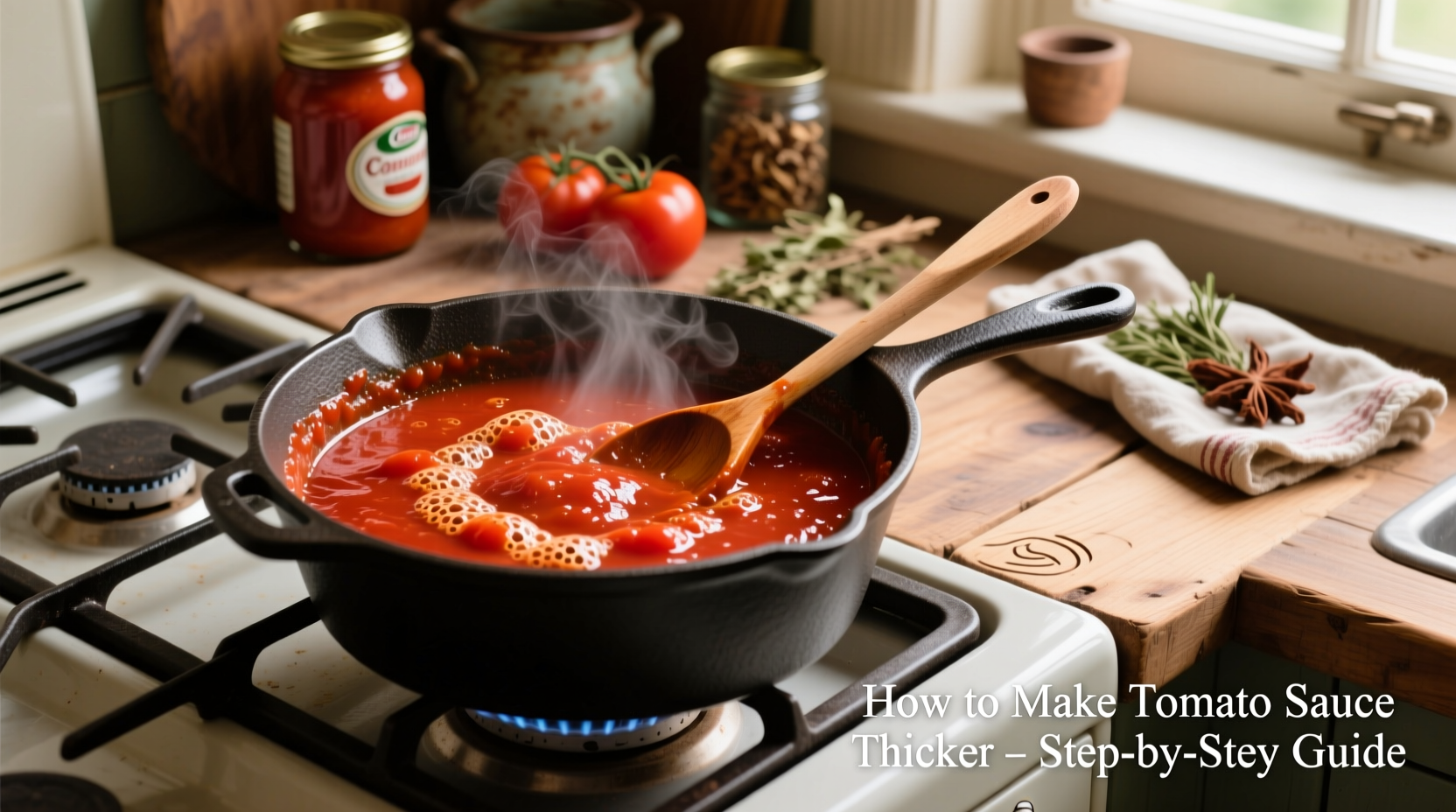The fastest way to thicken tomato sauce is to simmer it uncovered for 15-30 minutes, allowing excess liquid to evaporate. For immediate results, create a cornstarch slurry (1 tablespoon cornstarch mixed with 1 tablespoon cold water) and whisk it into your simmering sauce. Tomato paste (2-3 tablespoons) also effectively concentrates flavor while thickening without altering texture.
Why Your Tomato Sauce Needs Thickening (And How to Fix It Right)
Nothing ruins a perfect pasta dish like watery tomato sauce sliding right off your noodles. Whether you're making marinara from canned tomatoes or simmering a slow-cooked ragu, achieving that ideal restaurant-quality consistency is crucial for flavor adherence and texture. As a professional chef with years of kitchen experience, I've seen countless home cooks struggle with thin sauces—and most mistakes come from not understanding the science behind thickening.
The Culinary Science Behind Sauce Consistency
Tomato sauce thickness depends on three key factors: water content, natural pectin levels, and cooking time. Commercial canned tomatoes often contain added liquid for preservation, while fresh tomatoes vary in water content based on ripeness and variety. The good news? You have multiple reliable methods to achieve perfect thickness without compromising flavor.
Immediate Fixes for Thin Sauce (When Dinner Can't Wait)
1. The Simmering Method: Nature's Concentrator
When your sauce is too thin but you've got 15-30 minutes, simmering uncovered is your best friend. This technique works because:
- Evaporation removes excess water while concentrating flavors
- No additional ingredients alter your recipe's balance
- Develops deeper flavor complexity through Maillard reaction
Pro tip: Stir occasionally but not constantly—letting the sauce sit on the bottom for brief periods creates flavorful fond that incorporates when stirred.
2. Cornstarch Slurry: The 5-Minute Rescue
For urgent thickening needs, a cornstarch slurry delivers instant results:
- Mix 1 tablespoon cornstarch with 1 tablespoon cold water
- Whisk slurry into simmering sauce
- Cook for 2-3 minutes until thickened
Important: Never add dry cornstarch directly to hot liquid—it will clump instantly. The cold water creates a suspension that evenly distributes when added to heat.
| Thickening Method | Time Required | Flavor Impact | Best For |
|---|---|---|---|
| Simmering/Reduction | 15-30 min | Enhances flavor | All tomato sauces |
| Cornstarch Slurry | 5 min | Neutral | Quick sauces, gluten-free needs |
| Tomato Paste | 5-10 min | Rich, concentrated tomato | Marinara, arrabbiata |
| Roux | 10-15 min | Subtle nuttiness | Creamy tomato sauces |
3. Tomato Paste Power Boost
Adding 2-3 tablespoons of tomato paste does double duty:
- Concentrates tomato flavor while thickening
- Provides natural pectin for better texture
- Creates richer color without artificial additives
Professional technique: Sauté the paste in olive oil for 2-3 minutes before adding to your sauce—this "cooks out" any raw flavor and deepens the umami profile.

Preventative Strategies for Perfect Sauce Every Time
Ingredient Ratios That Guarantee Thickness
Prevention beats correction. When starting from scratch:
- Use 1 part tomato paste to 3 parts crushed tomatoes
- Add vegetables like carrots or onions that release natural pectin
- Limited added liquid—only what's necessary for deglazing
The Blanching Secret for Fresh Tomato Sauces
When using fresh tomatoes, remove excess water before cooking:
- Score tomatoes and blanch in boiling water for 30 seconds
- Transfer to ice water and remove skins
- Cut in half and squeeze gently to remove seeds and excess liquid
This simple step reduces water content by up to 40% according to USDA food composition data, preventing watery sauce from the start.
Critical Context Boundaries: When Not to Thicken
Not all thin sauces need intervention. Consider these scenarios before thickening:
- Pasta water integration: Reserve ½ cup starchy pasta water before draining—it helps sauce adhere to noodles without excessive thickness
- Freezing considerations: Sauces thicken when frozen; under-thicken slightly if freezing for later use
- Dish purpose: Pizza sauce should remain thinner than pasta sauce for proper application
Food Safety First: Thickening Without Risk
The FDA's Center for Food Safety and Applied Nutrition emphasizes that tomato sauce must maintain proper acidity (pH below 4.6) to prevent bacterial growth. When thickening:
- Never thicken by simply turning up the heat—this can cause scorching
- Keep sauce at or above 140°F (60°C) during preparation
- Refrigerate within 2 hours of cooking
For canning purposes, consult the National Center for Home Food Preservation guidelines as thickening agents affect acidity levels.
Troubleshooting Common Thickening Mistakes
"My sauce is too thick!"—The Fix
Add liquid gradually:
- 1-2 tablespoons reserved pasta water
- Low-sodium vegetable broth
- Red wine for depth (¼ cup max)
Never use plain water—it dilutes flavor. Always add cold liquid to hot sauce slowly while whisking.
"My sauce tastes starchy"—The Culprit
This happens when:
- Cornstarch isn't fully cooked (needs 2+ minutes at simmer)
- Slurry wasn't properly mixed before adding
- Too much thickener was used
Fix: Continue simmering for 5 minutes while stirring. If still starchy, add ¼ cup tomato juice to dilute.
Professional Chef's Final Tip
"The perfect tomato sauce coats the back of a spoon but still flows slowly," explains Chef Thomas Keller in Ad Hoc at Home. Test thickness by drawing a line through sauce on a spoon—if it holds its shape for 2 seconds before running, you've hit the sweet spot.











 浙公网安备
33010002000092号
浙公网安备
33010002000092号 浙B2-20120091-4
浙B2-20120091-4